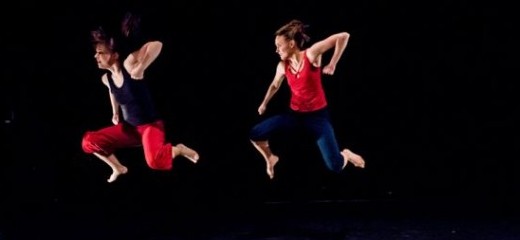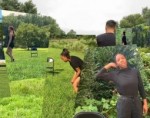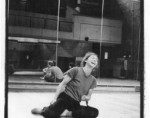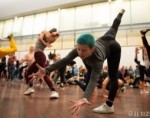
Danced Duets, Costumes and Caravaggio–a conversation with Judith Stein
by Lisa Kraus and Judith Stein
Talking over what you’ve seen at a show is especially interesting when your companion is not a dance insider. After sitting next to writer and “recovering curator” (her description) Judith Stein at An Evening of Duets, we decided to record our conversation in an online chat the next afternoon.
LK: I am really interested in your perspective as someone who is steeped in visual art. How does that inform your watching of dance? What is most compelling to you to look at? You mentioned the feet of one particular dancer...
JS: Spectators’ eyes wander, caught by moving body parts, the swish of a costume, or, in one case last evening, by one dancer's dirty feet. In another piece, I couldn't help but be drawn to the unusual and likely unconscious way another dancer’s big toe pressed upward while the rest of the toes moved downward. A slight detail, but fascinating. As it happens, I'd recently seen some of the great women dancers of India perform at the Metropolitan Museum of Art, and watching them I was nearly gape-jawed when I noticed that for a few seconds in one dance, the dancer sickled her toes in and then out while her heel was still planted on the floor. Amazing.
LK: You were equating dancers with the subjects of particular paintings too. Last night you mentioned Caravaggio.
JS: Yes, the dancer's dirty feet brought to mind the image of the dead Virgin painted by Caravaggio who used as a model a poor dead girl fished out of the Tiber. He carefully recorded her soiled feet, a detail which caused a scandal. As a visual person, when I watch a dancer the image calls up not only other dancers I've seen, but other bodies I've seen in paintings or sculpture.
LK: Some of the dances had costuming that might have made for good painting subjects--I'm thinking of how Melissa Chisena draped herself with voluminous fabrics, or of Alicia Sehn and Elizabeth Tolis, the two ladies in flowing burgundy dresses.
JS: Yes, I've always found costumes of great interest, and those were striking. In general, if I lose interest in a particular dance, I find myself carefully figuring out how the costumes were made! It's also fun to try to put yourself back in time, to when the choreographer first spoke with the costume designer (assuming they are different people), and try to divine what directions, hopes, and expectations were communicated, and then attempt to figure out if what you see is successful on that count.
LK: Getting interested in how and why and zooming in on curious details seems fresh and good to me. The typical way of looking at a dance--for its structure, timing, and space use can be so limiting. Several of the pieces seemed to live in a realm of urgency or tense dramatic intent. Do you try to parse story at all? How do you relate to the emotional tone in dances?
JS: Drama. Emotion. This is a great question that's hard to rattle off an answer to. In a few pieces I was put off by overly dramatic, overly earnest emotions conveyed by the movements. But that may be my post-modern ironic bent talking. Only a few of the pieces were clearly narrative, and I tended to appreciate them. I didn't try to impose a story line, it was offered easily by the actions.
LK: In the half-film/half-live dance piece by Scott McPheeters and Lindsay Browning there were two contrasting sections of content. You mentioned thinking of the piece being in a duet with itself.
JS: I've looked up the definition of "duet," and it seems to hinge on a double performative aspect, as in “it takes two to tango.” But what about the old tap dance routine of "You take it," where one watches while one acts, and then they switch roles, surely a duet, yes? I found the piece in question like a session of "You take it."
LK: First they got to be these characters onscreen who were comedic parodies, sort of like Portlandia people. And then their dancerly selves got their turn.
JS: In other pieces I found the use of text/voice overly problematic, which is to say that the words were nowhere near as interesting as the movements themselves were, some comments and conversations were so mundane and boring.
LK: Like the piece by the company Real Live People with its conversation about lying and making excuses?
JS: Yep. It was like being trapped next to two people talking on a bus. There's surely room for the prosaic in art, but you have to know how to use it.
LK: It's hard for dancers to use words well…that's something that more recently has become part of performers’ training in a good way, I think. But when dancers begin to incorporate all kinds of elements into performance, they may not have worked those chops nearly as much as they have worked on their physical training.
JS: Some wag once said that the art in restaurants is as good as the food in museums, which is to say, that if you're not a gifted writer, it's best to stay away from words.
LK: Ouch. So how about rhythm, which was at play in the very first piece. How was that for you, hearing Kalila Kingsford Smith and Grace Stern clapping and stamping in the dark?
JS: It was intriguing, inviting, and my interest was rewarded soon thereafter with a sweet, smart, and sassy dance that delighted me.
LK: What about it?
JS: The energy the dancers radiated, the fun they seemed to be having.
LK: Lauren Putty White's piece was in a very different mood. It was the only male/female duet on the program and had more powerfully dynamic dancing than most of the pieces. Its sound-score included a siren, and overall there was a feeling of panic. How did it strike you?
JS: I was captivated by the partnering, the pace, the rhythms. It had my full attention. No mind wandering here!
LK: Also, it made me think about how so often a duet is a "love" duet. A pas de deux of some kind. On this show more of the dances were for “twins” or sisters or weird companions...
I liked it that duet could mean a duet with a poet (Anne Adele Wight) or a cellist (Cory Neale) too. A dance by Treeline Dance Works started and ended with one of the two dancers crying, being comforted.
JS: Yes, I found it a fresh idea--dancers are always conscious of using "the breath," and here was breath as expression of pure emotion. Although she was comforted, as the piece ends, the pain or panic returns; it was not a happy ending, which I liked, as life doesn't always have happy endings.
LK: Here's another thought...All the pieces were VERY short. That meant that you could see 10, but they were little tastes. Like tapas. How does that format strike you?
JS: I liked the sampler aspect of the evening. The really sparkling pieces were like a sip of champagne (or ginger ale) and when the action was a little flat, it was a mercy not to have it go on and on.
An Evening of Duets, produced by Melissa Chisena, Community Education Center, February 6-8. Performances in the February 6 show were by Kalila Kingsford Smith & Grace Stern, Chisena Danza, Real Live People, Alicia Sehn, Scott McPheeters & Lindsay Browning, Tara Madsen-Robbins, Jennifer Yackel & Cory Neale, Treeline Dance Works, Putty Dance Project and Amy Lynne Barr. Included on other evenings were Rachael Hart and Daniel Fetecua/Pajarillo Pinta’o Dance Company.
Judith E. Stein is a writer and former curator at the Pennsylvania Academy of the Fine Arts who specializes in postwar American art. She received a Warhol Foundation/Creative Capital Arts Writers Grant (2008) for her forthcoming book, Eye of the Sixties, A Biography of Richard Hu Bellamy, to be published by Farrar, Straus & Giroux. Judith is married to TD Writer Jonathan Stein.By Lisa Kraus
February 11, 2015






.png)


